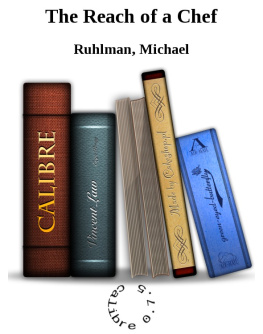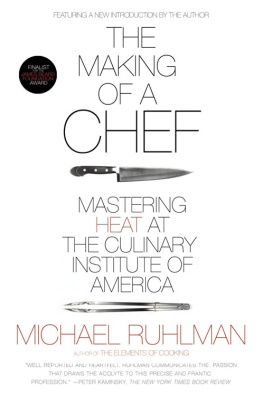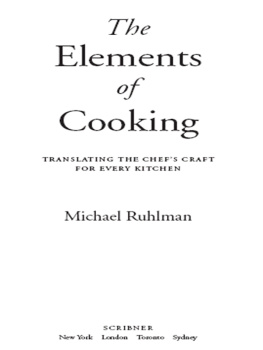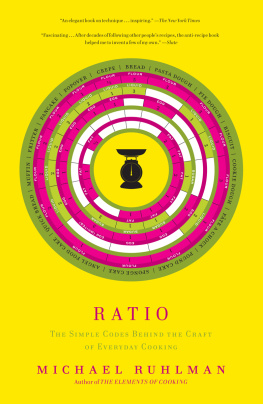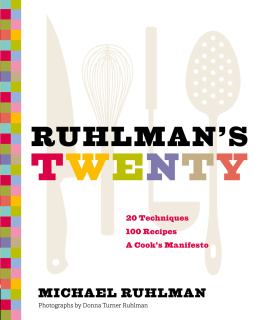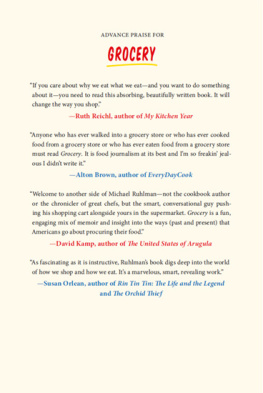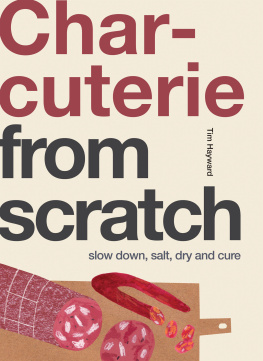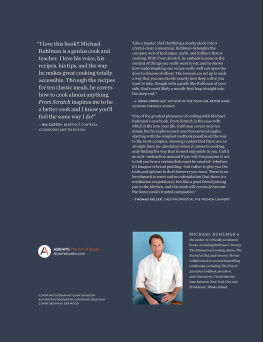Other food books by Michael Ruhlman
BOUCHON (with Thomas Keller, Jeffrey Cerciello, and Susie Heller)
A RETURN TO COOKING (with Eric Ripert)
THE SOUL OF A CHEF: THE JOURNEY TOWARD PERFECTION
THE FRENCH LAUNDRY COOKBOOK (with Thomas Keller and Susie Heller)
THE MAKING OF A CHEF: MASTERING HEAT AT THE CULINARY INSTITUTE OF AMERICA
CHARCUTERIE

The Craft of Salting, Smoking, and Curing
.....
Michael Ruhlman
and Brian P olcyn
Illustrations by Yevgeniy Solovyev
W . W . NORTON & COMPANY NEW YORK LONDON
For Julia and Donna,
Alana, Alex, Carmen, Dylan, Ben, Addison, and James
CONTENTS


C harcuterie is everywhere around us, but most in America dont recognize it as such. Bacon, sausages, hams, pts, and terrines are all part of this great culinary specialty. In the world of cooking, charcuterie is in a class by itself.
My first exposure to charcuterie, like so many Americans, was cold cuts: Oscar Mayer bologna and salami. Unless you were the child of European immigrants, you probably never had a great dry-cured sausage, a saucisson sec, or a soppressata as a kid. When I was growing up in Florida in the 1970s, charcuterie like that wasnt available. Thanks to the extraordinary changes in this country, you can now find it in upscale grocery stores.
Americans travel more than ever and are more likely to explore regional specialties throughout the world. As we move through our lives, as we travel and explore, our reference points change. Our experiences of charcuterie gather and we learn that those baloney cold cuts we took for granted as kids have their roots in mortadella and the other emulsified sausages popularized in Bologna; that packaged grocery store salami is a descendant of the dry-cured sausages called salume , works of great craftsmanship and great flavor.
Making those food connections, and recognizing those reference points, is important because it deepens the experience of cooking and eating. And understanding that the historical roots of charcuterie reach hundreds of years back, and that the fundamental methods of charcuterie, namely curing and preserving, reach all the way back to earliest civilization, makes us realize that this specialty is one of the most important kinds of cooking there is.
In this book, Michael Ruhlman and Brian Polcyn subdivide charcuterie into its component parts, first describing curing meats, fish, and vegetables with salt. They explore the many variations of the pt and the versatility of the confit. But of all the food we call charcuterie, my favorite by far is the sausage, and sausage is the backbone of Charcuterie . Whats best about this part of the book is that Michael and Brian not only describe in detail the various stages of sausage making but also isolate the key steps and techniques that can elevate a good sausage to a great one. In addition, they give what amounts to a primer in the key points of dry-curing sausages and whole cuts of meat, a segment of charcuterie thats really in its infancy here in America.
This book is important because so few people understand what charcuterie is or recognize it as the great branch of cooking that it is. Charcuterie represents some of the oldest methods of cooking, and so has deep culinary roots and an important role in the development of civilization. It has a long and varied place in restaurant kitchens, and is now enjoying something of renaissance in the American restaurant, especially with regard to dry-cured items. Charcuterie is amply represented at my bistro, Bouchon, and is also at home at the French Laundry and Per Se, my four-star restaurants.
At Per Se, Joshua Schwartz makes a form of lardo, salting and dry-curing fatback from just above the pork shoulder, and serves very very thin slices of it. For a special dish, hell wrap a slice of lardo around an asparagus tip and a slice of truffle and serve it as a canap. But lardo is delicious on its own. Its texture and flavor are amazingtheres nothing like itand it couldnt be easier to make. All it takes is good porkthat is, organic or farm-raised porkwhich is now available not just to restaurant chefs but to home cooks everywhere via the Internet. I want to stress how simple and natural the method is: good pork, salt, and time are the principal ingredients. That something so easy to make is also so extraordinary to eat is part of its pleasure.
Charcuterie is appropriate at every level of dining, and it runs the entire gamut of cooking. That includes home cooking, where charcuterie once played a huge role and will againnot one day far in the future but now. Some charcuterie techniques couldnt be simpler. A BLT is one of the best uses of charcuterie I know, for instance. Making your own sausage and frying up some patties is no more difficult than grinding your own hamburger, but to season it yourself, and to cook and eat what youve made, is a very special thing. Charcuterie is sometimes relegated to fall and winter cooking, but it should be an important part of your kitchen year-round.
A final reason Charcuterie is important: it recognizes the pig as the superior creature that it is. From a culinary standpoint, the pig is unmatched in the diversity of flavors and textures it offers the cook and the uses it can be put tofrom head to tail, from ham to tenderloin, its a marvel. A piece of pork belly can be brined, roasted, grilled, sauted, dry-cured, braised, or confited, with widely varying results. This is a very hopeful time for the pig in America, and this book underscores that fact.
Come to think of it, this book reminds me what a hopeful time it is for cooking in general in this country. This may well be the most exciting time ever to be a cook and a chef in America. And Charcuterie is a perfect example of why.
Thomas Keller

.....
S ometimes books are the result of a surprise, in this case a surprise (via duck confit) that became a fascination that transformed into a quest to understand this food that we still categorize under the broad label of charcuterie, a range of preparations from sausages to pts, confits to cured salmon, all of which have some sort of cure and preservation at their core. This is not a thirty-minute-meals cookbook, not a book to help you get dinner on the table fast or tell you how to whip together an impromptu dinner party for eight. It is a book about craftsmanship, for people who love to cook and eat. In this chapter, Brian and I describe its genesisthat is, why on earth we would devote two years of our lives and an entire cookbook to a love song to animal fat, to salt, to the pigas well as how to use our recipes.
A powerful mania descended on me a decade ago when I first tasted duck confit ( confit de canard ): duck salted for hours, if not days, then poached gently in its own fat, and then submerged in that fat and left to ripen. What amazed me first was that you could poach meat in fat. I found the idea of poaching anything in fat appealing, and the idea of poaching a rich fatty meat in more fat enormously so. But what truly hooked me was how amazing the duck confit was to eatthe salty, gently spiced meat was deeply, richly succulent, the skin crispy.
I began to explore the technique. You could do so many things with duck confit: stew it in some beans (as in cassoulet, the well-known French bean dish), make a salad of it with some greens and a vinaigrette, put it on mashed potatoes or polenta, add chunks of it to a country pt. You could even tuck it between slices of Wonder Bread and it would still be fantastic.
Next page

